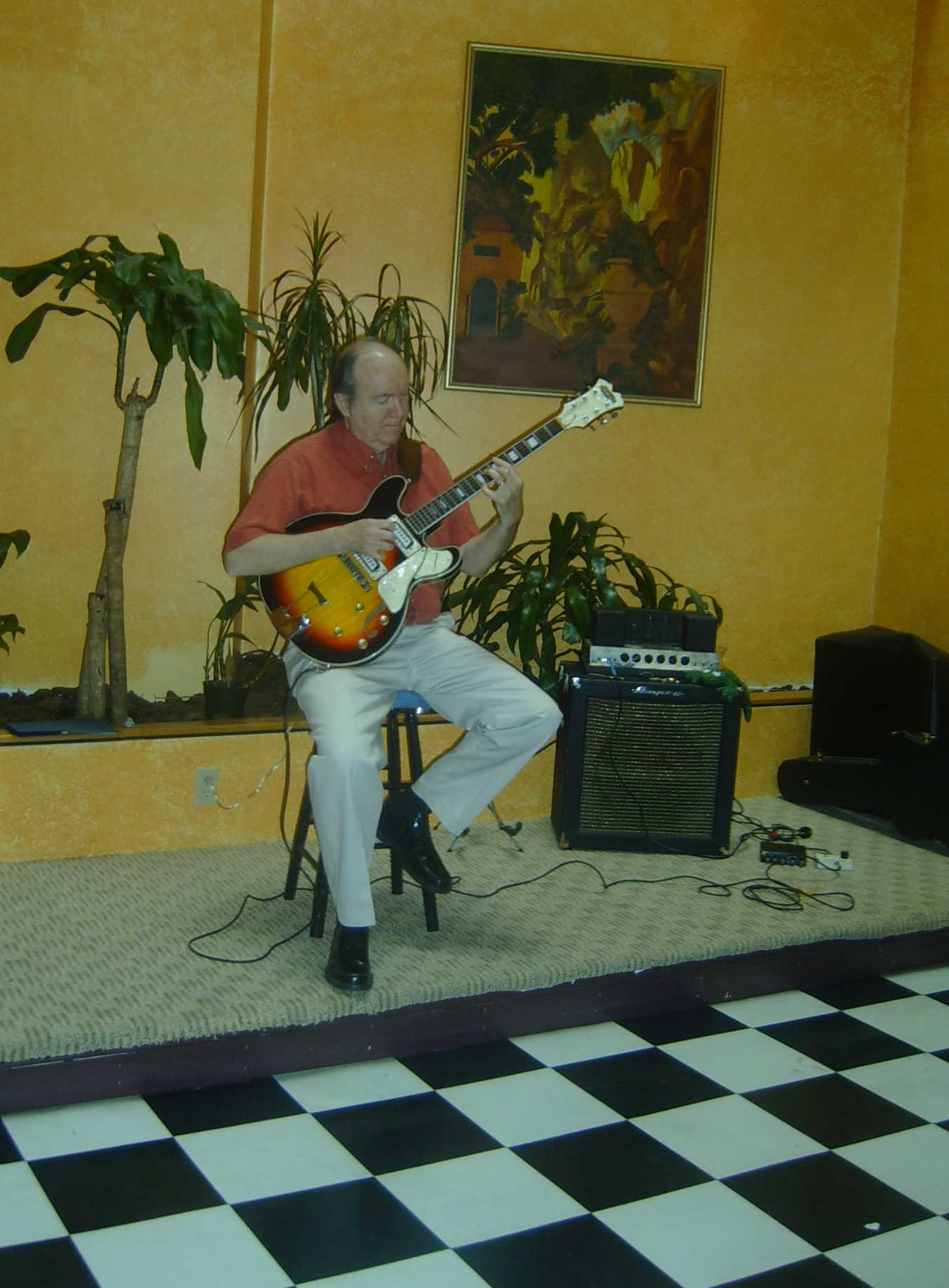
My setup: Aria guitar, Ampeg B-15 amp

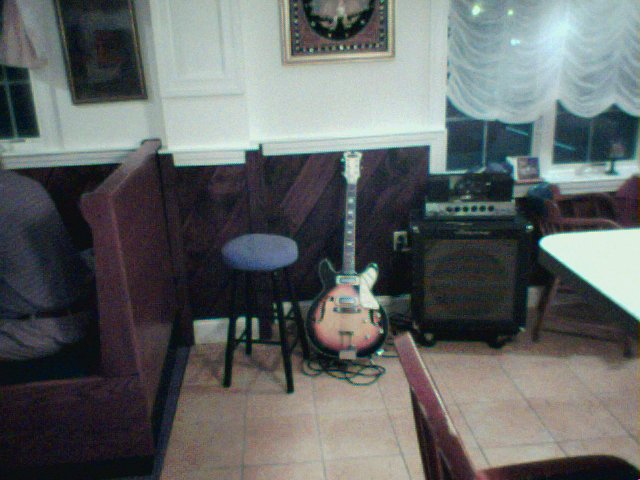
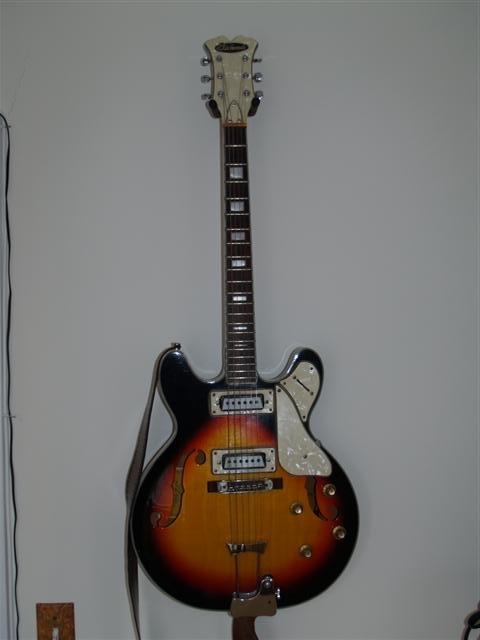 \
\
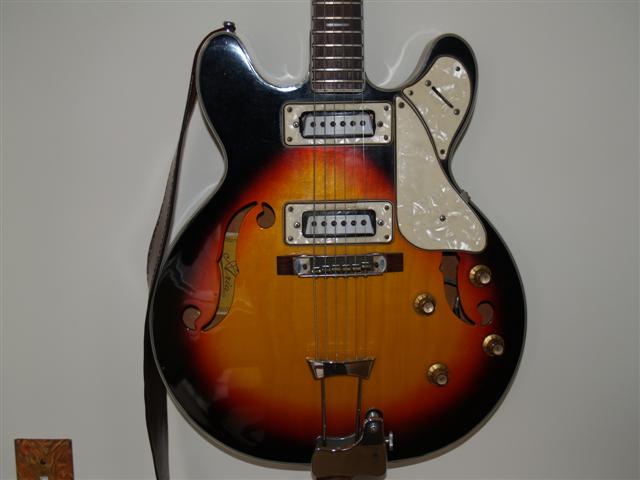 \
\
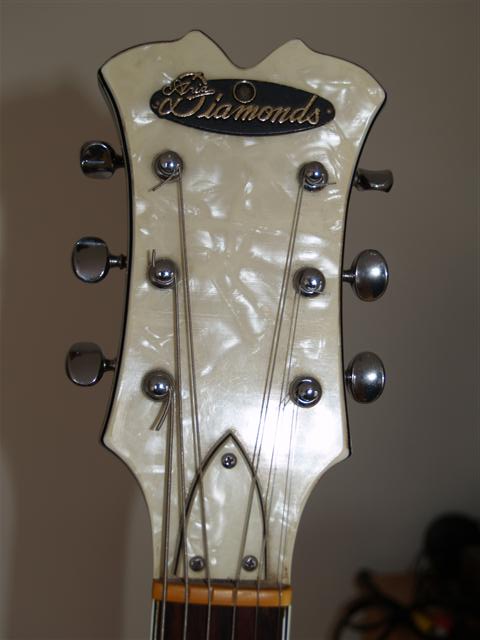 \
\
It may seem hard to believe, but that strange-looking guitar in the photo on my home page is my main ax, and has been for over thirty years.
I didn't really choose my equipment: it chose me. This story is a long one, so settle in.
In the mid-60's I was working around Boston with a blues band called the Blues Children. I was playing bass in the band, and noodling with guitar on the side. There were two guitarists in the band, and both played Fender Mustang guitars. The band played folk festivals, opening for Sun House, the Chambers Brothers, and the like, and we played the coffee house circuit and so were in the same circuit with players like John Lee Hooker, and groups like the Paul Butterfield Blues Band. The rhythm guitarist was really into authentic blues, and wanted to find a guitar that had a really nasty, funky, beat-up sound. So he went into a department store and bought the cheesiest guitar he could find. Yes, it was the Aria. It didn't have the right sound for the group, so Mizzy went on playing the Fender on stage and playing Robert-Johnson-like stuff on the Aria for his own enjoyment. After a while he loaned the Aria to me. The Blues Children broke up and I bought the Aria from Mizzy -- for $60. Best investment I ever made.
I was playing a lot of folk-influenced finger-style stuff at the time, and I found the wide neck on the Aria, and hence the spacing between the strings, really helped. Years later, when I developed my pick-and-finger styles, the Aria proved to be perfect. Not only did the string spacing facilitate pick-and-fingers, but highs were sweet and clear, while the lows were rich without being boomy. On Mizzy's advice, I had angled the pickup so that the side under the high strings was closer to the strings and the bass side was lower. This allowed me to use a bass amp, or to crank the bass setting (I used a Fender Dual Showman Reverb head for a while, with either a one-15" or two-15" cabinet), so I got strong bass without being overwhelming.
In 1972 I started teaching at Berklee. Students would take one look at my guitar and say, "What is that?. About that time, Howard Roberts came by Berklee and gave a clinic. He said, "If you're not playing a Les Paul -- or whatever guitar happens to be in style this year -- no one will believe a note you play." He was right. The Aria is a weird looking guitar. In the 70's, that was un-cool. (In the 80's that guitar was way cool!). One of my students said, "I feel bad for you, having to play that thing," and loaned me his Epiphone Sheraton. I played that for a while, but I decided that was not what I wanted. After a while I bought a hollow-body Guild T-50. So for the students who "listened with their eyes", I was cool. The Guild has a soft, sweet sound, great for jazz combo work, but for solo guitar work, it just doesn't have the presence in the highs. It is a great guitar and I used it all through the 80's on General Business (GB) gigs (yes, I even played disco on it, sad to say), and with various jazz groups.
Gradually, I started using the Aria more and more. Jazz and GB were getting louder and I was starting to get some feedback on the Guild, and having some trouble cutting through the band. So, depending on the gig, I'd play one ax or the other.
In 1996 I got a letter from one of my former students, Alex Case, asking if I'd play solo guitar at his wedding. (You'll read a lot more about Alex elsewhere on my site. To jump ahead in the story -- he engineered my solo CD and he's played a major role in my musical life recently). I told Alex that I was honored by his request, but that I didn't play solo guitar. That was true, to an extent. To explain, I have to digress.
In the late 60's and early 70's I did some solo gigs as a guitarist/singer -- on the Aria. I sang Beatles, Dylan, James Taylor, etc. I've never been much of a singer, but I managed to get gigs. I'd play a few solo guitar pieces on the gig, to give my voice a rest, and I gradually came to realize that it was my guitar playing that people liked; they tolerated my singing.
So when Alex asked me to play solo at his wedding, I was being honest when I said I didn't play solo guitar. I had a few pieces down, and that was it. But Alex insisted. Now the whole story of Alex and Amy's wedding is a tale unto itself and will eventually be told elsewhere on this site. But suffice it to say that Alex got me started on my solo career. I worked up the song he wanted for the Recessional ("A Kiss To Build a Dream On") and enough tunes to play the reception. I used the Guild on that job, and what I discovered was that, combined with the Ampeg, it was just too dark. Later Alex and Amy hired me for a private party, and I played the Aria. I'll save that story for later.
So my Aria is quite unique. I've seen a couple of others like it, usually in pawn shops, and they all sound like trash. Why mine sounds so good, I'll never know. But for more than 30 years people have been telling me it sounds great, and my ears tell me it sounds great. Can't ask for more than that.
I remember once seeing a column in Guitar Player magazine (I used to write for them, so I used to read the magazine regularly) about the Aria Diamonds. It was the "Off the Wall" column, where the author (I forget his name) used to write about weird guitars. As I recall, he said that the Aria Diamonds was modeled after the only semi-hollow body that D'Angelico ever made. In those days, Japanese guitars had a reputation for being cheap copies of American guitars, so the story makes sense. If you look at the headstock on the Aria, and the way the "Diamonds" is written, it does look like an imitation of the D'Angelico headstock -- a very bad imitation. If the story is true, I sure would like to play that D'Angelico!
Now for the Ampeg. Once again, Mizzy gets credit for introducing me to that amp. After I auditioned for the Blues Children, he said to me, "You play great, but we have to get you some equipment." I had a junky bass and amp. Mizzy took me to a music store. We tried a bunch of amps, and he picked an Ampeg B-12. Like a B-15 but a 12" speaker. We did some gigs, and the amp just didn't cut it. Mizzy called it "The Castrato". We went back to the music store and traded up to the B-15. As I was rolling it out of the store, Mizzy said, "Clucky"(that was his nick-name for me), "You just bought and amp that will last you the rest of your life." That was 1966. Mizzy was right -- so far, at least.
I remember the first time I ever heard a guitar played through a B-15. It was in a club in Boston's "Combat Zone", in the 60's. In those days, some of the best bands played in the Zone. I went there with Mizzy to hear what the bands were doing. I was underage, so we had to just stand in the doorway. There was a guy playing a Telecaster through a B-15. I couldn't believe it! The sound was so sweet and clear! At that time, I was only playing bass on gigs, through my B-15; but a seed was planted.
In 1965 Mizzy had introduced me, indirectly, to my Mosrite bass. He took me into Wurlitzer music in Boston (at that time it was near Summer Street) and introduced me to Bob Cavenaugh. Bob had me try a few basses, listened to what I liked and disliked about each, and finally said, "You're a guitar player, right?" He realized I was looking for a bass with a neck like a guitar. He said, "In a few weeks we have a new brand, Mosrite, coming in. I think you'll like it. I'll give you a call when they come in."
I did like the Mosrite bass. I also like Bob Cavenaugh and we struck up a professional relatioship that was to last several decades.
About 1968, after the Blues Children had broken up, some of the remnants got together and formed a group call The Heat Palace. I played guitar (and occassionally upright bass) in that group, and that's when I first put the Aria and the Ampeg together.
These days I use use an Alessis Nanoverb digital reverb with the Ampeg. I use the "Plate 2" setting with the signal mixed very dry and a fairly long sustain. The Ampeg, being a bass amp with a closed back, is very dry.
I've always felt that reverb should not be noticeable, and that it should not be used as a crutch. Connecting notes and chords on the guitar, creating legato phrasing, is very difficult. Reverb can be used to cover up the gaps. My old Fender Dual Showman had a great reverb, but I found that I was using it, too often, as a crutch. So when I started playing General Business gigs in the early 70's and wanted a small amp, I bought a Polytone Mini-Brute, and I deliberately bought one without reverb, just to force myself to develop real legato phrasing.
I also have a Peavy Studio 112 that I use when space is cramped, either on the gig, or in the car on the way to the gig. It has a spring reverb, which is OK, but does not compare with a good Fender spring reverb. The amp sounds OK at very low volumes, but it sounds a little ragged and thin as the volume goes up.
So, to return after this long digression, when I played at Alex's wedding I used the Guild and the Ampeg. He loved the sound. He and his wife hired me to play a few parties in New Hampshire. One was at his home, where he also had a recording studio. That was the beginning of my first solo CD, Act One. It was then that the combination of the Aria and the Ampeg really started to become my trademark sound. The making of that CD is a story to itself, which, at some point, I'll post on this site.
[still to come: photos of -- and stories about -- my Mosrite bass, Travis Bean fretless bass, and Guild T-50 hollow-body guitar.]
Last Update: 5/28/2007